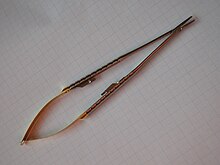Super microsurgery
The Super microsurgery is a new technique and development of Microsurgery , which allows very small vessels (eg. Arteries , veins and lymphatic vessels with a diameter of less than 1 mm (0.3 to 0.8 mm)) to prepare each other and to sew. The method expands the surgical possibilities to close soft tissue defects after accidents, tumor removal or in chronic wounds with free tissue transfers (so-called flaps ). Particularly fine surgical instruments and microscopes with up to 40x magnification are required. Extremely thin sutures are used which, according to the USP classification, have a thickness of 12-0, i.e. less than 0.1 mm.
application areas
Perforator flaps
Current fields of application are e.g. B. Replantations of a severed fingertip, and the smallest vascular anastomoses of veins and arteries with free tissue transfer, so-called perforator-to-perforator anastomoses . Perforators are tiny blood vessels that penetrate a muscle or a connective tissue sheath vertically in the direction of the overlying skin and subcutaneous tissue.
DIEP and SCIA flap surgery
The so-called free tissue flaps are completely detached from their place of origin and replanted at the destination. Examples of free flaps with perforator anastomosis are DIEP flaps ( deep inferior epigastric perforator ), anterolateral thigh flaps (ALT), SCIA flaps ( superficial circumflex iliac artery perforator ) and the lower leg perforator flaps ( medial ). The perforator-to-perforator technique prevents potential complications at the tissue extraction sites ("lifting defect morbidity") and shortens the operating time.
Lymphatic vessels
Another possible area of application is the treatment of lymphedema of the upper or lower extremity, for example after surgery or radiation therapy.
By suturing several lymph vessels to superficial veins, the lymph can drain from the painfully swollen region of the body. In addition, the body's own lymph nodes can be lifted from a healthy donor region and transplanted into the congested drainage area. In order for the lymph nodes in the recipient region to heal, their own blood supply is connected to a vein and an artery. In this way, the lymph node in the new recipient region can take over the drainage.
Individual evidence
- ↑ a b I. Koshima, T. Yamamoto, M. Narushima, M. Mihara, T. Iida: Perforator flaps and supermicrosurgery. In: Clin Plast Surg. 37 (4), Oct 2010, pp. 683-689.
- ↑ JP Hong: The use of supermicrosurgery in lower extremity reconstruction: the next step in evolution. In: Plast Reconstr Surg . 123 (1), 2009, pp. 230-235.
- ^ DW Chang: Lymphaticovenular bypass for lymphedema management in breast cancer patients: a prospective study. In: Plast Reconstr Surg. 126, 2010, pp. 752-758.

